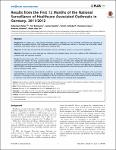Results from the First 12 Months of the National Surveillance of Healthcare Associated Outbreaks in Germany, 2011/2012
Haller, Sebastian
Eckmanns, Tim
Benzler, Justus
Tolksdorf, Kristin
Claus, Hermann
Gilsdorf, Andreas
Sin, Muna Abu
Background: In August 2011, the German Protection against Infection Act was amended, mandating the reporting of healthcare associated infection (HAI) outbreak notifications by all healthcare workers in Germany via local public health authorities and federal states to the Robert Koch Institute (RKI). Objective: To describe the reported HAI-outbreaks and the surveillance system’s structure and capabilities. Methods: Information on each outbreak was collected using standard paper forms and notified to RKI. Notifications were screened daily and regularly analysed. Results: Between November 2011 and November 2012, 1,326 paper forms notified 578 HAI-outbreaks, between 7 and 116 outbreaks per month. The main causative agent was norovirus (n = 414/578; 72%). Among the 108 outbreaks caused by bacteria, the most frequent pathogens were Clostridium difficile (25%) Klebsiella spp. (19%) and Staphylococcus spp. (19%). Multidrug-resistant bacteria were responsible for 54/108 (50%) bacterial outbreaks. Hospitals were affected most frequently (485/578; 84%). Hospital outbreaks due to bacteria were mostly reported from intensive care units (ICUs) (45%), followed by internal medicine wards (16%). Conclusion: The mandatory HAI-outbreak surveillance system describes common outbreaks. Pathogens with a particular high potential to cause large or severe outbreaks may be identified, enabling us to further focus research and preventive measures. Increasing the sensitivity and reliability of the data collection further will facilitate identification of outbreaks able to increase in size and severity, and guide specific control measures to interrupt their propagation.
Dateien zu dieser Publikation
Keine Lizenzangabe
Verwandte Publikationen
Anzeige der Publikationen mit ähnlichem Titel, Autor, Urheber und Thema.
-
2015-05-01ZeitschriftenartikelLow-level Circulation of Enterovirus D68–Associated Acute Respiratory Infections, Germany, 2014 Reiche, Janine; Böttcher, Sindy; Diedrich, Sabine; Buchholz, Udo; Buda, Silke; Haas, Walter; Schweiger, Brunhilde; Wolff, ThorstenWe used physician sentinel surveillance to identify 25 (7.7%) mild to severe infections with enterovirus D68 (EV-D68) in children and adults among 325 outpatients with acute respiratory infections in Germany during ...
-
2005-07-31ZeitschriftenartikelLeptospirosis in Germany, 1962–2003 Jansen, Andreas; Schöneberg, Irene; Frank, Christina; Alpers, Katharina; Schneider, Thomas; Stark, KlausEpidemiologic trends of human leptospirosis in Germany were investigated by analyzing national surveillance data from 1962 to 2003 and by conducting a questionnaire-based survey from 1997 to 2000. After a steady decrease ...
-
2009-02-25ZeitschriftenartikelThe epidemiology of pertussis in Germany: past and present Hellenbrand, Wiebke; Beier, Dietmar; Jensen, Evelin; Littmann, Martina; Meyer, Christiane; Oppermann, Hanna; König, Carl-Heinz Wirsing von; Reiter, SabineBackground: Current and past pertussis epidemiology in the two parts of Germany is compared in the context of different histories of vaccination recommendations and coverage to better understand patterns of disease ...

